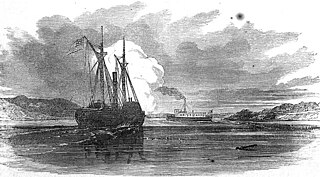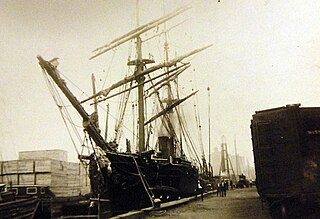Related Research Articles

A steamship, often referred to as a steamer, is a type of steam-powered vessel, typically ocean-faring and seaworthy, that is propelled by one or more steam engines that typically move (turn) propellers or paddlewheels. The first steamships came into practical usage during the early 1800s; however, there were exceptions that came before. Steamships usually use the prefix designations of "PS" for paddle steamer or "SS" for screw steamer. As paddle steamers became less common, "SS" is assumed by many to stand for "steamship". Ships powered by internal combustion engines use a prefix such as "MV" for motor vessel, so it is not correct to use "SS" for most modern vessels.

A tugboat or tug is a marine vessel that manoeuvres other vessels by pushing or pulling them, with direct contact or a tow line. These boats typically tug ships that cannot move well on their own, such as those in crowded harbours or narrow canals, or those that cannot move at all, such as barges, disabled ships, log rafts, or oil platforms. The tugboat, for its size, is the most powerful craft afloat. Some are ocean-going, some are icebreakers or salvage tugs. Early models had steam engines, and modern ones have diesel engines. Many have deluge guns, which help in firefighting, especially in harbours.

A motorboat, speedboat or powerboat is a boat that is exclusively powered by an engine.

HMS Research was a small ironclad warship, converted from a wooden-hulled sloop and intended as an experimental platform in which to try out new concepts in armament and in armour. She was launched in 1863, laid up in 1878 and sold for breaking in 1884, having displayed serious limitations as a warship.

Sophia Jane was the first paddle steamer to operate in the coastal waters of New South Wales (NSW). She was launched on the Thames in 1826 and arrived in Sydney in May 1831.

An aerial torpedo is a torpedo launched from a fixed-wing aircraft or helicopter from the air which subsequently drops into the water, after which the weapon propels itself to the target.

Marine propulsion is the mechanism or system used to generate thrust to move a ship or boat across water. While paddles and sails are still used on some smaller boats, most modern ships are propelled by mechanical systems consisting of an electric motor or engine turning a propeller, or less frequently, in pump-jets, an impeller. Marine engineering is the discipline concerned with the engineering design process of marine propulsion systems.

CFAV Firebrand is a Fire-class fireboat in the Royal Canadian Navy designed by Robert Allan Ltd.. Firebrand is based in CFB Esquimalt, on Vancouver Island. Her sister ship CFAV Firebird was based in CFB Halifax and decommissioned in 2014.

SS Sirius was a wooden-hulled sidewheel steamship built in 1837 by Robert Menzies & Sons of Leith, Scotland for the London-Cork route operated by the Saint George Steam Packet Company. The next year, she opened transatlantic steam passenger service when she was chartered for two voyages by the British and American Steam Navigation Company. By arriving in New York a day ahead of the Great Western, she is usually listed as the first holder of the Blue Riband, although the term was not used until decades later.

Luna is a historic tugboat normally berthed in Boston Harbor, Massachusetts. Luna was designed in 1930 by John G. Alden and built by M.M. Davis and Bethlehem Steel. She is listed on the National Register of Historic Places and is a U.S. National Historic Landmark. In 1985, the Luna was designated as a Boston Landmark by the Boston Landmarks Commission.

MV Lady Rose is a small, single-screw, diesel coastal vessel, which operated on the west coast of British Columbia, Canada.

SS Archimedes was a steamship built in Britain in 1839. She was the world's first steamship to be driven successfully by a screw propeller.

Kulshan was a steamship which operated on Puget Sound from 1910 until 1929. When built, Kulshan was one of a newer type of inland steamships constructed entirely of steel, and was then considered one of the finest vessels ever to operate on Puget Sound.

HMS Pelican was an Osprey-class sloop built for the Royal Navy in the mid-1870s. She was launched in 1877 and was sold to the Hudson's Bay Company in 1901. She was scuttled in 1953.

SS Brulin was a lake freighter that worked the North American Great Lakes routes from 1924 to 1960. She was renamed Outarde in 1939, and James J. Buckler in 1960, shortly before she ran aground and sank during salvage operations. Brulin was built by Palmers Shipbuilding and Iron Company, Hebburn-on-Tyne and launched on 31 July 1924, for the Montreal Forwarding Company. She was built to the maximum dimensions of the canal locks that preceded the St Lawrence Seaway.
Henry Roe Campbell was an American surveyor and civil engineer. Campbell contributed to American railroading and bridge-building in the first half of the 19th century. Campbell patented his 4-4-0 design in February 1836, just a few months before the patent law was changed to require that claims include proof of originality or novelty.

The Type V ship is a United States Maritime Commission (MARCOM) designation for World War II tugboats. Type V was used in World War II, Korean War and the Vietnam War. Type V ships were used to move ships and barges. Type V tugboats were made of either steel or wood hulls. There were four types of tugboats ordered for World War II. The largest type V design was the sea worthy 186-foot (57 m) long steel hull, V4-M-A1. The V4-M-A1 design was used by a number of manufacturers; a total of 49 were built. A smaller steel hull tugboat was the 94-foot (29 m) V2-ME-A1; 26 were built. The largest wooden hull was the 148-foot (45 m) V3-S-AH2, of which 14 were built. The smaller wooden hull was the 58-foot (18 m) V2-M-AL1, which 35 were built. Most V2-M-AL1 tugboats were sent to England for the war efforts under the lend-lease act. The Type V tugs served across the globe during World War II including: Pacific War, European theatre and in the United States. SS Farallon and other Type V tugs were used to help built Normandy ports, including Mulberry harbour, on D-Day, June 6, 1944 and made nine round trips to Normandy to deliver Phoenix breakwaters.

Vigilance is a fireboat operated by Long Beach, California. It is the second of two large fireboats Long Beach commissioned and the largest on North America's West Coast.

Splinter fleet or Splinter navy was a nickname given to the United States wooden boats used in World War II. The boats served in many different roles during the war. These boats were built in small boatyards on the West coast and East coast, Great Lakes and the Gulf of Mexico. They could be built quickly, in just 60 to 120 days. Most of the boats were built by boatyards that already had the tools and knowledge from building yachts, sailboats and motor boats. Many were built by craftsmen in family-owned small businesses. Under the Emergency Shipbuilding Program and War Shipping Administration contracts went out to over fifty boatyards across the country. The boats were built for the US Navy, the, United States Army Air Forces, United States Coast Guard, and US Army. Some of the wooden boats went to Allied nations on the Lend-Lease program.
Weyerhaeuser Steamship Company was a was a and cargo Liner company founded in Tacoma, Washington. Weyerhaeuser Steamship Company was founded by Weyerhaeuser Company in 1933. Weyerhaeuser is one of the largest lumber and paper companies in the United States. First called the Weyerhaeuser Timber Company which started with ships for towing logs in the Northwestern United States. Weyerhaeuser started Weyerhaeuser Timber Company with a ship he acquired in 1892. The log towing ship was a 140-foot sternwheeler built for the partnership, Weyerhaeuser and Denkman Company. In 1923 Weyerhaeuser added to ocean lumber cargo ship the SS Pomona and the SS Hanley. The two ships took lumber to the East Coast. In 1933 F. Weyerhaeuser starts the Weyerhaeuser Steamship Company and moves the headquarters to Newark, New Jersey. At the outbreak of World War II the US government orders the four Weyerhaeuser to take supplies to the British army in Egypt. The next year the other four company's ships are requisitioned by the War Shipping Administration. During World War II the Weyerhaeuser Steamship Company was active in charter shipping with the Maritime Commission and War Shipping Administration. During wartime, the Weyerhaeuser Steamship Company operated Victory ships and Liberty shipss. The ship was run by its crew and the US Navy supplied United States Navy Armed Guards to man the deck guns and radio. The most common armament mounted on these merchant ships were the MK II 20mm Oerlikon autocannon and the 3"/50, 4"/50, and 5"/38 deck guns. In 1942 the SS Potlatch and the SS Heffron were sunk by German U-boats torpedoes. After the war, Weyerhaeuser Steamship Company purchased four Liberty ships for intercoastal shipping service. In 1950 Weyerhaeuser Steamship Company purchases the Pacific Coast Direct Line and moves its headquarter from Newark to San Francisco. In 1962 the Weyerhaeuser Line is started and Weyerhaeuser Steamship becomes a division of Weyerhaeuser Company.
References
- 1 2 Edward J. Moran at www.tugboatinformation.com.
- ↑ Steamship Historical Society of America, Steamboat Bill: Journal of the Steamship Historical Society of America, Volume 65, Issues 265-268, p. 74, 2008.
- 1 2 3 4 Carl Hoffman, "On Board the World's Most Powerful Tugboat", Popular Mechanics .